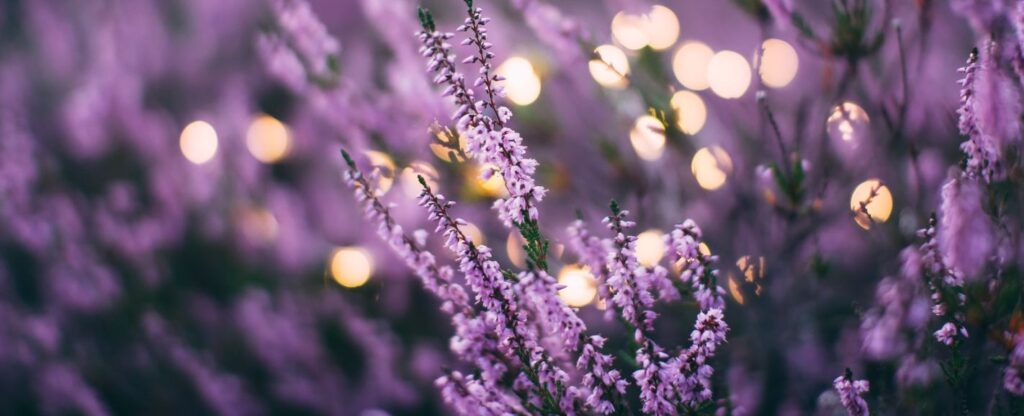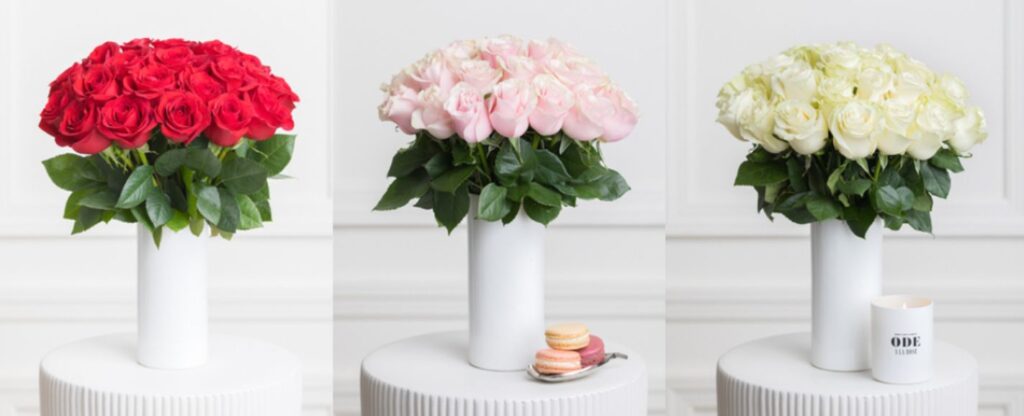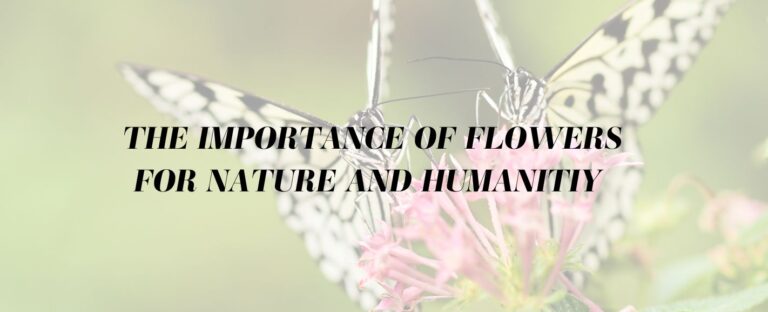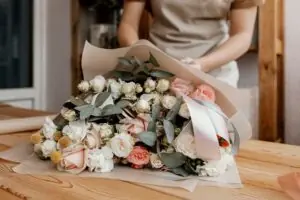Can you imagine a world without flowers?
Their delicate beauty graces our gardens, their intoxicating aroma fills our homes, and their color palette portrays our landscapes. But it’s not just their aroma and attractive looks and colors that captivate us.
According to a study conducted by the University of California, bees—those tireless dancers twirling from bloom to bloom—contribute to nearly 35% of the world's food crop production. Besides, would we ever savor the sweetness of honey, the fruit of their labor, without their symbiotic relationship with flowers?
Moreover, how would we express our deepest emotions without the language of flowers?
The global cut flower market, as reported by Gitnux, was worth nearly 29.9 billion U.S. dollars in 2021- a testament to the role flowers play in expressing our deepest sentiments. They translate emotions into a language more potent than words can convey.
As we delve into this narrative, take a moment to reflect on the monumental role these seemingly delicate blooms play. They are not just accessories to our world but pivotal elements that support and enrich our ecosystems and emotional landscapes.
So, as you journey through this exploration, pause to appreciate the profound significance of flowers, and take a moment to express your deepest devotions or sympathy through some of the numerous Ode a la Rose arrangements.
Our world is blessed with vibrant hues, captivating fragrances, and delicate forms of flowers. Far from mere embellishments, these blossoms hold profound importance for both nature and humanity. Flowers touch our lives in myriad ways through every bud that blooms, often unnoticed. Let's delve deeper into these incredible creations' multifaceted roles in our world.
Express our Feeling and Emotions with Flowers
Have you ever found solace in a bouquet of comforting marigolds or expressed unspoken love with a single red rose? Flowers have been the universal language of emotions since time immemorial. Each bloom symbolizes a unique sentiment.
Here are a few fascinating examples:
- Pink carnations are a symbol of a mother's undying love.
- White lilies often symbolize purity and virtue.
- Yellow tulips convey pleasant thoughts and sunshine.
- The bright red of a poppy is often associated with consolation in times of death.
Just as words articulate our thoughts, flowers express our emotions, sometimes more eloquently. Their silent whispers fill the voids of our unsaid words, subtly communicating our deepest sentiments.
Releases our Body from Tension and Anxiety
Have you ever wondered why a walk in a blooming park uplifts your spirits?
A study by the University of North Florida found that being around flowers significantly reduces stress and anxiety levels. Their vibrant colors and tranquil beauty trigger our brain's pleasure centers, releasing endorphins that make us feel happier, relaxed, and more optimistic.
Flowers can contribute to our well-being in various ways:
A Japanese study found that exposure to floral scents can positively influence the parasympathetic nervous system, reducing heart rate and promoting relaxation.
Researchers at Rutgers University found that the presence of flowers leads to increased contact with family and friends, contributing to overall happiness.
Another study published in the Journal of Physiological Anthropology revealed that active interaction with indoor plants, like repotting, can reduce physiological and psychological stress.
As you can conclude for yourself, from serving as a balm for our strained nerves to nudging us towards a state of tranquillity, flowers genuinely have a therapeutic effect.
Medicinal Purposes of Flowers
Flowers aren't just visually therapeutic but also potent healing agents.
They've held a pivotal place in traditional medicine, curing ailments, bolstering immunity, and promoting overall health.
According to the World Health Organization, about 80% of the world's population still relies on traditional plant-based medicine, underscoring the healing power of flowers.
Here are some remarkable flowers with well-documented medicinal properties:
- Marigold (Calendula): This vibrant flower is a garden staple and a powerful healer. It's used in ointments and teas to soothe skin inflammations, burns, and wounds.
- Lavender: Famous for its soothing fragrance, lavender is often used in aromatherapy to relieve stress and anxiety. It's also found in balms and oils for treating skin irritations and burns.
- Hibiscus: Beyond its striking beauty, hibiscus is a therapeutic powerhouse. It's known to lower blood pressure, support digestion, and even strengthen the immune system.
- Passionflower: Traditionally used to treat insomnia and anxiety, passionflower can have calming and sleep-inducing effects.
- Milk Thistle: This thorny plant, with its distinctive purple flowers, is often used to support liver health, thanks to its active ingredient, silymarin.
Suppose we continue to harness these natural resources responsibly. In that case, we will also continue to benefit from the botanical wisdom of our ancestors while paving the way for a greener, healthier future.

Air Filtration Through Flowers and Plants
Flowers contribute significantly to our planet's air filtration. They absorb carbon dioxide and release oxygen during photosynthesis, helping us breathe. Furthermore, some plants have an added advantage - they are natural air purifiers.
NASA's Clean Air Study found that certain flowering plants, like chrysanthemums and peace lilies, can filter out harmful toxins, thereby purifying our indoor air. It's fascinating that these delicate blossoms are hardworking environmental caretakers.
Let's delve into some of the best air-purifying flowers and plants you can bring into your home:
- Peace Lily: This beautiful plant not only adds to the aesthetics of your space but also eliminates harmful toxins like benzene and formaldehyde, improving indoor air quality.
- Chrysanthemums: Bright and delightful, chrysanthemums work diligently to filter out common toxins found in glue, paint, plastics, and detergents.
- Spider Plant: Easy to care for and resilient, spider plants are excellent at fighting pollutants, including carbon monoxide and xylene.
- Aloe Vera: Known for its medicinal properties, aloe vera also purifies the air by absorbing airborne compounds from paint or cleaning agents.
- Gerbera Daisy: This cheerful flower is particularly effective at removing trichloroethylene, a common pollutant in the air released by dry cleaners.
- Snake Plant: A popular choice for indoor spaces, snake plants are effective at filtering out formaldehyde, a common toxin found in cleaning products, toilet paper, tissues, and personal care products.
With every toxin they absorb, they breathe life into our spaces, making our homes healthier and our world a bit cleaner.
Multiple Commercial Applications of Flowers
Beyond their natural beauty and environmental benefits, flowers have numerous commercial applications that power economies globally. From the food industry to cosmetics, from healthcare to landscaping, the presence of flowers is far-reaching.
Here are a few key commercial uses of flowers:
- Food Industry: Flowers like roses, hibiscus, and elderflower are used in food and beverages for their unique flavors and aesthetic appeal. Edible flowers are a gourmet trend in many world cuisines.
- Cosmetics: Many skincare and beauty products contain flower extracts. For instance, rose water is a popular toner, while chamomile is often found in soothing creams and lotions.
- Perfumery: Flowers form the heart of the fragrance industry. Iconic scents like Chanel No.5 would only exist with jasmine and rose.
- Healthcare: As discussed earlier, many flowers like echinacea and lavender are used in pharmaceuticals due to their medicinal properties.
- Landscaping: From public parks to private gardens, flowers play a significant role in landscaping and horticulture, adding beauty and diversity.
Benefits for Insects
Flowers are fundamental to the survival of many insects, providing them with necessary nutrients and playing a crucial role in their reproductive processes. This symbiotic relationship is essential for maintaining biodiversity.
Here are some of the significant ways flowers benefit insects:
- Nectar and Pollen: Flowers provide nectar and pollen, which are primary food sources for many insects, including bees and butterflies.
- Habitat: Some insects, like ladybugs and certain beetle species, use flowers as shelter, protecting them from predators and harsh weather conditions.
- Reproduction: Flowers assist in the reproduction of insects. Bees, for instance, collect pollen from flowers for their offspring, inadvertently aiding in the pollination process, which is vital for plant reproduction.

Flowers as Food
Flowers as food? It's not as bizarre as it sounds. Edible blooms have been adding up to our regular dishes for centuries, adding a burst of color and unique flavors.
Have you ever tasted a dish adorned with these vibrant delicacies? Here are a few flowers that have found their way from the garden to the kitchen:
- Nasturtiums: With their bright, peppery flavor, nasturtiums make an excellent addition to salads and sandwiches.
- Violets: Violets are often candied and used to decorate cakes and pastries, providing a subtle, sweet flavor.
- Marigolds: Known as the "poor man's saffron," marigold petals are used to color and flavor dishes.
- Squash Blossoms: A delicacy in many cuisines, squash blossoms are often stuffed with cheese and fried.
Improves Garden Beauty
Think about the transformative power of flowers in our surroundings.
Whether in window boxes, public parks, or sprawling gardens, flowers undeniably enhance aesthetics and create an ambiance of peace and beauty. Can you picture your favorite spot blooming with your favorite flowers?
Here are some widely used flowers for enhancing garden beauty:
- Roses: The classic rose, with its rich hues and mesmerizing fragrance, adds a touch of elegance to any garden.
- Tulips: With their various colors, tulips are perfect for creating a vibrant and cheerful landscape.
- Lavender: Its purple blooms and soothing fragrance make lavender a popular choice for many gardeners.
- Sunflowers: Known for their towering height and bright yellow petals, sunflowers make a striking statement.
Source of Honey Production
We often associate honey production with bees, but what about flowers? Without the nectar from flowers, there would be no honey. Isn't it awe-inspiring to consider this sweet gift the product of a perfect synergy between flowers and bees?
In addition, check out some fascinating facts about honey production:
- Variety in Flavor: The flavor and color of honey change based on the types of flowers the bees visit. Clover honey, for instance, has a mild taste and light color, while buckwheat honey is darker and has a more robust flavor.
- Bee Communication: Bees communicate with each other about the location and quality of food sources using a 'waggle dance.'
- Honey Stomachs: Bees have a separate 'honey stomach' for storing nectar collected from flowers. This nectar is then regurgitated and dehydrated to produce honey.
- Long Shelf Life: Thanks to its low moisture content and acidic pH, honey does not spoil. Archaeologists have found honey pots in ancient Egyptian tombs that are over 3000 years old but still perfectly edible!

Wrapping Up
The examples we included in this article are but a fraction of the intricate web of life in which flowers play a critical role, signifying their profound importance of flowers for both: nature and humanity.
Flowers touch every aspect of our lives, from the food we eat to the beauty we admire, from medicinal remedies to the honey we savor. It's a testament to the incredible, multifaceted roles that these beautiful and resilient organisms play in our world. Whether you decide to purchase a floral arrangement, buy organic food, or fix a quick plant-based drink with a floral scent - Ode a la Rose is here to back you up!
Since flowers facilitate vital ecological interactions and contribute to the biodiversity and health of our ecosystems, we have devoted ourselves to not only selling flowers but making sure we understand them on a more profound level.





